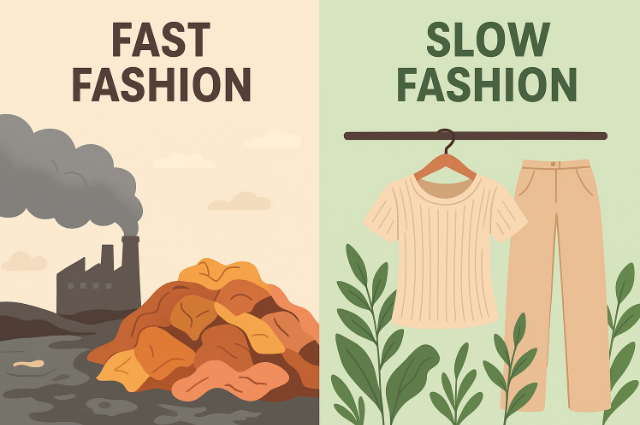
What is fast fashion?
Fast fashion is a term that represents and describes the rapid production of inexpensive low low-quality clothing that often mimics popular styles of fashion labels, big-name brands, and independent designers. By endlessly offering new trends at cheap prices, it encourages consumers to continually buy more clothing. The rise of the fast fashion industry in the late 20th and early 21st centuries has had enormous consequences, from its myriad environmental impacts to its exploitation of garment workers.
History of fast fashion
It emerged in the 1970s when retailers began exporting production to countries, particularly in Asia, where they could pay workers lower wages than in Western countries. It took hold in the 1990s as companies accelerated output to keep up with trends. Whereas new clothing collections will be expected four times a year, but fast fashion has more frequently 36 collections a year.
- In the 1980s, globalisation accelerated both the production and distribution processes. Still, mainstream fashion became even more about chasing new trends.
- 1990s, when fashion first started on 31st December,1989, the term was used to talk about how Zara was taking garments from design to stores in only two weeks.
- 2000s - The era introduced e-commerce, more familiar for online shopping sites like H&M, Zara took over the high street and started moving away from fashion’s traditional seasons.
- 2010-2020s fast fashion became even faster, and is called ultra-fast fashion. Producing 52 micro seasons a year and churning out thousands of new garments per week. People are now buying 60% more clothes than they did in the year 2000.
Real issue of fast fashion
Fast fashion can appear innocent, on a superficial level, but there are many hidden costs. Most buyers these days are aware that the industry is harmful in some way or another, but the extent is not common knowledge. Some common issues faced by, such as
- Exploitation of workers
- Pollutes the environment
- Psychological pressure
- Greenwashing
- Rewards the ultra-rich
Exploitation of workers
Garment workers often work in unsafe conditions. With extremely low wages that aren't really close to a living wage, with an absence of fundamental human rights. The reason is to reduce as many costs as possible, so brands take advantage of outsourcing in countries where the protection of workers' rights is virtually nonexistent. Child labour may be used in some cases.
Pollutes the environment
Producing excessive amounts of clothing at shockingly cheap prices insists on a disposable culture, as the clothing is not meant to be long-lasting due to the choice of cheap materials that don’t last. The amount of clothing thrown away has doubled in the past 20 years, averaging at as few as 7 wears per clothing item.
Psychological pressure
A constant release of new styles promotes an overconsumption mentality, making people feel like they need more and more stuff to feel comfortable. Some even suggest they feed a kind of addiction through instant gratification and the release of dopamine. Not to mention that more environmentally friendly shoppers can feel eco-anxiety when faced with shopping for fast fashion.
Greenwashing
It’s a deceptive tactic and a marketing technique aimed at creating an illusion of ecological responsibility. Green communication doesn’t always mean that the company is environmentally responsible. This is why the concept of greenwashing is frequently used by NGO’s to denounce the companies that claim environmental concerns while their activities and practices prove otherwise. Some fashion brands try to gain a feminist brand image, but they won’t share with steps they are taking to ensure the safety of their garment workers, who are 80% women.
Rewards the ultra-rich
Despite brands being complicit in factory suppliers not paying their workers a living wage, the fast fashion industry employs some of the richest people in the world, many of them multi-billionaires.
Dark side of fast fashion
According to an analysis, fashion production comprises 10% of total global carbon emissions, as much as the emissions generated by the European Union. The industry dries up the water resources and pollutes rivers and streams, while 85% of all textiles go to dumps each year. Even washing clothes releases 500,000 tons of microfibers into the ocean each year, the equivalent of 50 billion plastic bottles.
The three main drivers of the industry’s global pollution impacts are dyeing and finishing (36%), yarn preparation (28%), and fibre production (15%). It claims that the fibre production has the largest impact on freshwater withdrawal and ecosystem quality due to cotton cultivation, while the dyeing and finishing, yarn preparation and fibre production stages have the highest impacts on resource depletion, due to the energy-intensive processes, based on fossil fuel energy.
According to the UN work convention on climate change, emissions from textile manufacturing alone are projected to skyrocket by 60% by 2030.
The environmental impact of fast fashion comprises the depletion of non-renewable resources, emission of greenhouse gases and the use of massive amounts of water and energy. The fashion industry of water, requiring about 700 gallons to produce one cotton shirt and 2,000 gallons of water to produce a pair of jeans.
The production of plastic fibre into textile is an energy-intensive process that requires large amounts of petroleum and releases volatile particulate matter and acids like
hydrogen chloride. Additionally, cotton, which is used in a large amount of fast fashion products, is also not environmentally friendly to manufacture. Pesticides, deemed necessary for the growth of cotton, present health risks to farmers.
Slow fashion
Slow fashion is a key the widespread reaction to fast fashion, and its environmental impact, the argument for hitting the brakes on excessive production, overcomplicated supply chains, and mindless consumption. It advocates for manufacturing that respects people, the environment and animals.
Adidas is experimenting with personalised gear to cut down on returns, increase customer satisfaction and reduce inventory. Ralph Lauren has announced that it will use 100% sustainably sourced key materials by 2025.
. . .
References
